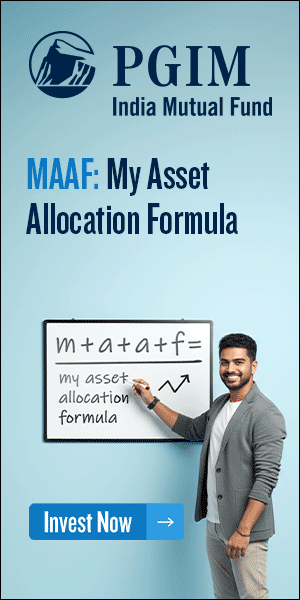Balanced Advantage Funds as a category: PGIM India Balanced Advantage Fund

The age old investing wisdom is “Buy low / Sell high”. To see if Indian investors are following this adage, we looked at the monthly net inflows in small cap funds since the beginning of FY 2023-24 and compared them with Nifty Small Cap 250 TTM PE multiples (see the chart below). You can see that the net monthly flows doubled from Rs 2,000 crores levels in April to more than Rs 4,000 crores levels by August despite the Small Cap index P/E value going up from 18X to nearly 25X. This shows that investor behaviour is usually driven by sentiments or herd mentality. As a result, investors often end up “buying high and selling low” and therefore, do not get the desired results. Balanced advantage funds may help investors take advantage of market movements by buying low / selling high.
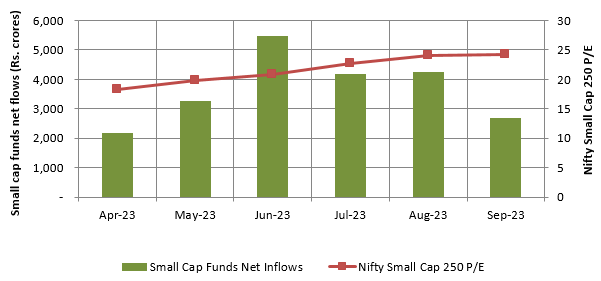
Source: AMFI, NSE, as on 29th September 2023
Balanced Advantage Funds
Balanced advantage funds are hybrid funds that use dynamic asset allocation strategy. In this asset allocation strategy, the asset allocation between equity and debt changes depending on market conditions. For example, a balanced advantage fund will reduce its equity allocation and increase its debt allocation as equity valuations increase. When equity valuation decreases, the fund may increase its equity allocation and reduce its debt allocation. SEBI has not mandated upper or lower asset allocation limits for dynamic asset allocation funds.
How Balanced Advantage Funds work?
By lowering net equity allocations when the market valuation is high, dynamic asset allocation aims to reduce downside risk, when the market corrects after peaking. Similarly, BAF will increase its net equity allocations and decrease its debt allocation as equity valuations fall (becomes cheap). By increasing equity allocations when valuations are low, the dynamic asset allocation model may generate higher risk adjusted returns for the investor.
There are various asset allocation models within the BAF category. Some funds use technical indicators e.g. momentum indicators to tactically change asset allocation. A lot of balanced advantage funds do not disclose their dynamic asset allocation models or disclose partially. You should try to understand the asset allocation model of the fund before investing.
Balanced advantage funds usually cap their debt allocation to 35% so that the scheme can enjoy equity taxation. If the net equity exposure needs to fall below 65% as per the dynamic asset allocation model, these funds use hedging to reduce the net equity allocation, but keep the gross equity exposure above 65% to ensure equity taxation.
Different dynamic asset allocation models can produce different risk adjusted returns
A common mistake which some investors make is to consider category level risk when investing in a mutual fund scheme. Within Balanced Advantage Funds category, scheme level risks at certain points in time can vary considerably. In the scatter plot diagram below, we plotted CAGR returns of all the schemes from the inception of PGIM India Balanced Advantage Fund (February 2021) to 29th September 2023 versus the maximum drawdowns of these schemes during this period. You can see that while most funds generated8 to 10% CAGR returns, the maximum drawdown ranged from -6% to -12% for these. Therefore, investors should understand the dynamic asset allocation model of the scheme and make informed investment decisions.
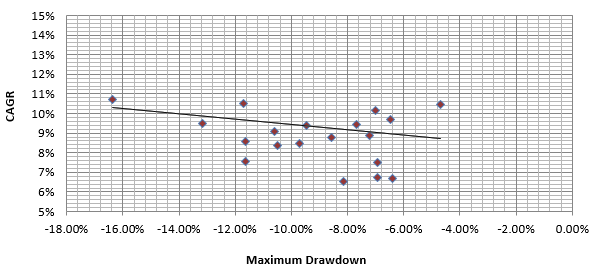
Source: Advisorkhoj Research, as on 29th September 2023. Schemes that were launched after the inception date of PGIM India Balanced Advantage Funds are not shown here.
About PGIM India Balanced Advantage Fund
PGIM India Balanced Advantage Fund was launched in February 2021 and has Rs 1,332 crores of assets under management with a total expense ratio of 2.07% for the regular plan (details as on 30th September 2023). The fund has given around 8.42% CAGR returns since inception. A.Anandha Padmanabhan, Vinay Paharia, Hitash Dang, Ojasvi Khicha and Puneet Pal are the fund managers of the scheme. The fund managers have combined experience of over 80 years.
Dynamic Asset Allocation model of the PGIM India Balanced Advantage Fund
Asset allocation for PGIM India Balanced Advantage Fund is guided by the time-tested Dynamic Advantage Asset Allocation Facility (DAAAF) model. The fund dynamically changes its asset allocation based on the deviation of the current P/E ratio of Nifty 500 from the long term average P/E of the index (as shown in the graphic below). 15 year rolling P/E of Nifty 500 Index is considered for the long-term P/E average.
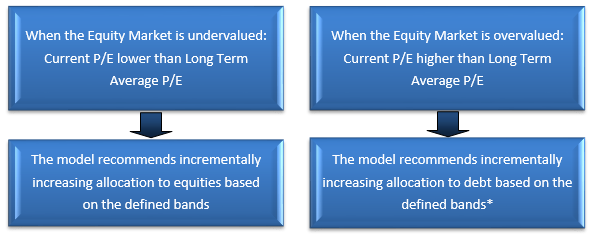
PGIM India Balanced Advantage Fund’s dynamic asset allocation model is scientific and transparent. Using this model, PGIM India Balanced Advantage Fund follows the “Buy Low, Sell High” mantra, allocates across equity and debt based on the market valuations. The fund maintains minimum 65% exposure to equity and equity related instruments (this ensures equity taxation for the fund), with directional equity exposure of at least 30% at all points of time.
Current Nifty 500 Valuations and Asset Allocation
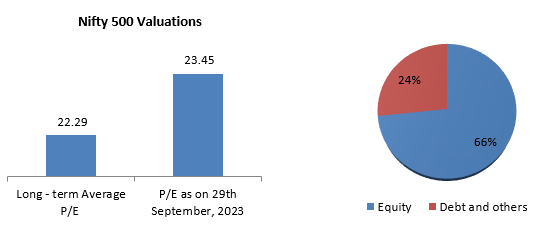
Asset allocation – PGIM India Balanced Advantage Fund versus peers
The chart below shows the net equity levels of different schemes in the BAF category as on 29th September 2023. You can see that schemes in this category maintain net equity levels from 40% to 80%. PGIM India Balanced Advantage Fund (66% net equity exposure) had higher net equity compared to the category average. Higher net equity levels imply that the model sees the current markets as sort of at equilibrium with risk and reward equally factored in and does not anticipate a sharp and lasting correction in the Indian markets. The average net equity exposure of the fund since inception has been 56.77%. The maximum net equity exposure was around 81% (when Nifty 500 P/E was around 22.75, December 2022) and minimum net equity exposure was around 30.44% (when Nifty 500 P/E ratio was around 28.8, July 2021). You can see that fund follows a consistent and scientific valuation driven approach to asset allocation.
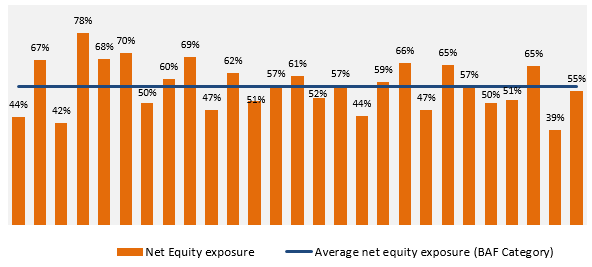
Source: Advisorkhoj Research, as on 29th September 2023. Only funds which have disclosed net equity exposures in monthly factsheets are shown in this chart.
Why is the equity exposure high? As mentioned, the deviation between the current Nifty 500 P/E ratio (as on 29th September) and the long term average is just 5.2%. Therefore, as per the model, the market is not in very expensive zone. This shows that PGIM India Balanced Advantage Fund may perform well if the market maintains its momentum from current levels.
How has asset allocation changed since December 2022?
You can see in the chart below that the net equity allocation of the fund has ranged from 65– 80% from December 2022 to September 2023.
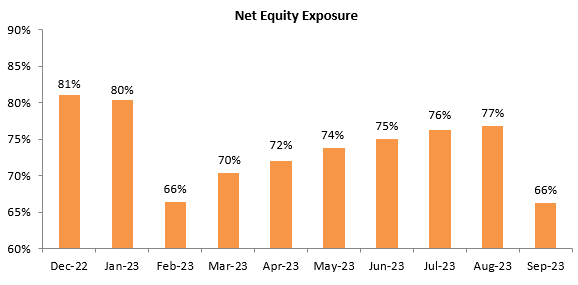
Source: PGIM MF, as on 29th September 2023.
Market cap composition of PGIM India Balanced Advantage Fund
The equity portion of the portfolio is large cap oriented, which may reduce downside risks in market downturns. Large caps have comprised around 75 to 80% of the equity portfolio with mid and small caps comprising the remaining part over the last 9 months (as on 29th September 2023). The mid and small cap portion of the portfolio may potentially generate alpha for investors. Currently the large cap allocation is around 77%, which is aligned with the average large cap allocation of Balanced Advantage Fund category.
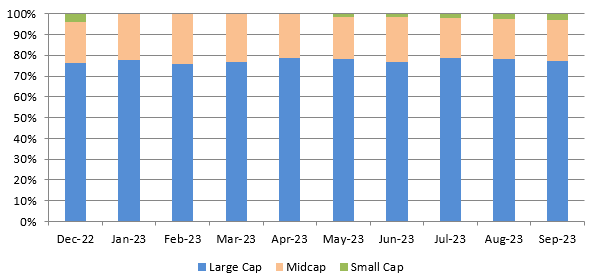
Source: PGIM MF, as on 29th September 2023.
Scheme Performance Lump Sum
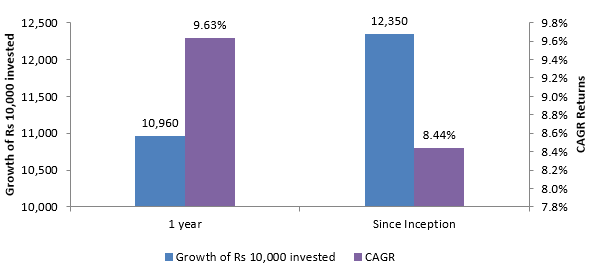
Source: Advisorkhoj Research, as on 29th September 2023
Scheme Performance SIP
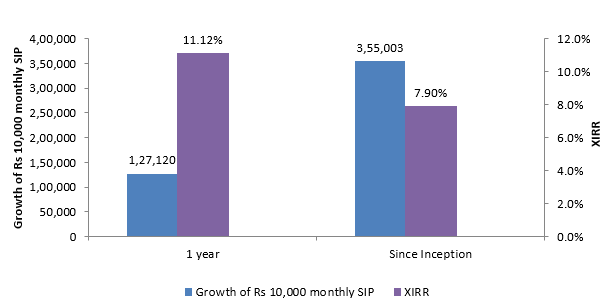
Source: Advisorkhoj Research, as on 29th September 2023
Who should invest in PGIM India Balanced Advantage Fund?
- Investors who want capital appreciation and income over long investment tenures
- Investors who do not want high volatility in their portfolios
- Investors with minimum 3 to 5 years investment horizon
- New investors or investors who do not have experience of volatile markets can invest in this scheme
- You should consult with your financial advisor or mutual fund distributor if PGIM India Balanced Advantage Fund is suitable for your investment needs.
Mutual Fund Investments are subject to market risk, read all scheme related documents carefully.
PGIM is the global investment management business of Prudential Financial, Inc. (PFI) USA, with USD 1.5 trillion1 in assets under management. We offer a broad range of investment capabilities through our multi-manager model along with experienced investment teams that assist you in achieving your financial goals. With a glorious legacy of 145 years, PGIM is built on the strength, stability and deep expertise in managing money. We offer you a long-term perspective, having weathered multiple market cycles, and see opportunity in periods of disruption.
Investor Centre
Follow PGIM India MF
More About PGIM India MF
POST A QUERY









